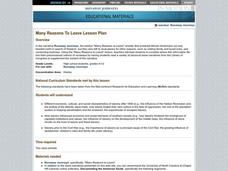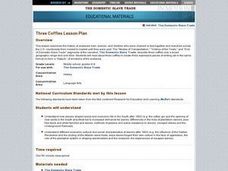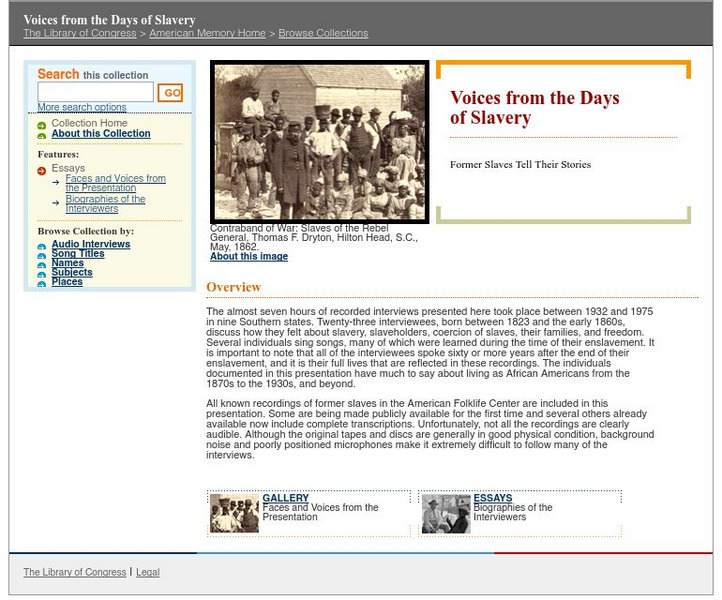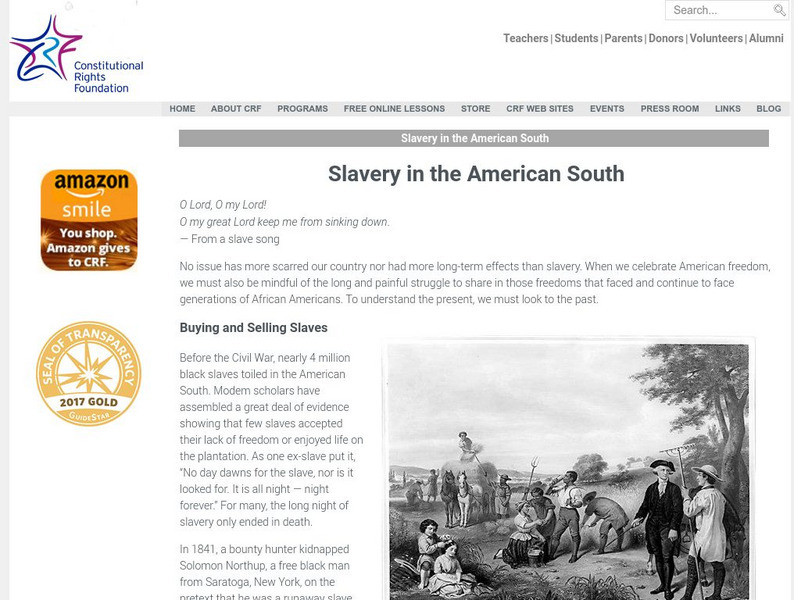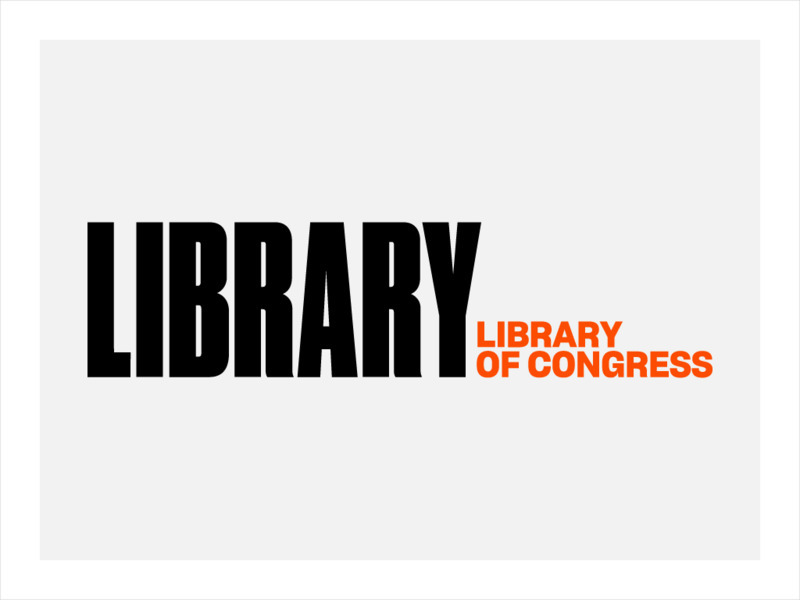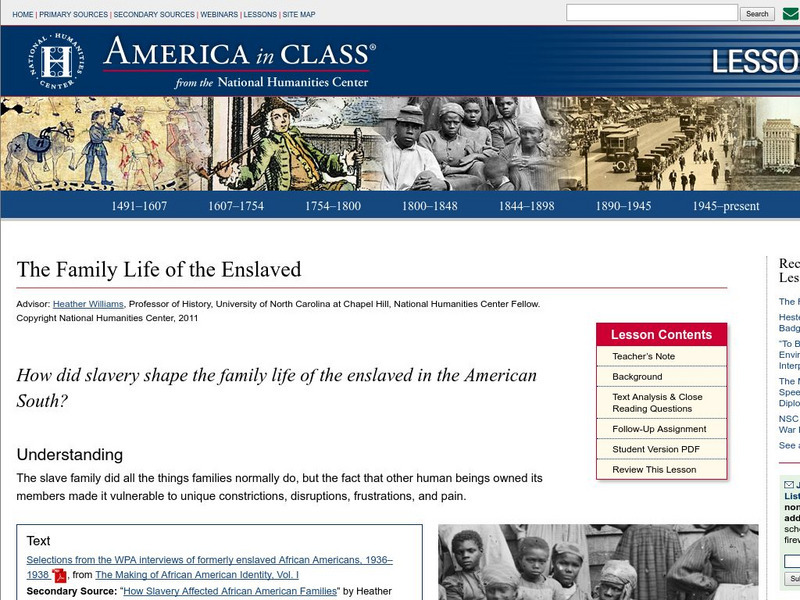Crafting Freedom
Sequencing of Events in the Slave Narrative of Henry "Box" Brown
What steps did Henry "Box" Brown take while planning his own escape from slavery? Learners work in groups to analyze segments of Brown's narrative and identify the sequence of the most important events of his story.
Gilder Lehrman Institute of American History
Slave Narratives: Frederick Douglass, Harriet Jacobs, and the Columbian Orator
Young historians practice in-depth, quality analysis of primary source texts in this three-lesson unit, which examines excerpts from the slave narratives of Frederick Douglass, Harriet Jacobs, and Caleb Bingham.
Curated OER
Reliving History through Slave Narratives
Helpful for an American literature or history unit, this lesson prompts middle schoolers to examine slavery in the United States. They read slave narratives that were part of the Federal Writers' Project and then conduct their own...
Curated OER
Studying the Life of Henry Bibb
After reading primary and secondary source materials about the life of Henry Bibb, individuals identify a core democratic value Bibb demonstrated and give examples drawn from their readings.
Curated OER
Reliving History Through Slave Narratives
Young scholars read slave narratives and retell the stories to the class, identifying sensory details. In this slavery lesson, students discuss the importance of sensory details, then read the slave narratives looking for specific...
Curated OER
Many Reasons To Leave
High schoolers read a variety of narratives from fugitive slaves, discuss the many reasons slaves had to leave and what dangers they faced when living as a fugitive. They write and present a fictional narrative incorporating their...
Curated OER
Three Coffles
Students read several slave narratives that comment on the ways in which slaves were transported from market to market. They write three original pieces expressing the viewpoint of a man, woman and child in captivity.
Curated OER
Unchained Memories
Eleventh graders consider what life was like for American slaves. In this primary source analysis instructional activity, 11th graders read slave narratives from Unchained Memories and then participate in a discussion about the...
Curated OER
Using Primary Sources in the Classroom:Slavery Unit: Point of View of Former Slaves
Students read slave narratives. In this Federal Writers' Project lesson plan, students explore slave narratives to discover details regarding legal status, roles of slaves, religion, family, and treatment of slaves.
Curated OER
MANY REASONS TO LEAVE
Students research different economic, cultural, and social characteristics of slavery after 1800, how slavery hindered the emergence of capitalist institutions and values, and slavery both prior to and after the Civil War.
Curated OER
Ex-Slave Narratives and WPA Interviews
Students analyze documents related to slave narratives and slave interviews. They complete a document analysis form to analyze the contnet and historiography of the documents. They write a paragraph detailing when and why the document...
National Humanities Center
National Humanities Center: Toolbox Library: Freedom, Making of African American Identity: V. 1, 1500 1865
Twenty nine primary sources-historical documents, literary texts, and visual images-that explore the qualities and conditions of African lives on the west coast before and during the European slave trade.
Library of Congress
Loc: Voices From the Days of Slavery
Extensive collection of interviews with former slaves who recount their experiences.
National Endowment for the Humanities
Neh: Edsit Ement: Perspective on the Slave Narrative
A lesson plan focusing on the the historical context of slave narratives, "Perspective on the Slave Narrative" introduces students to the abolitionist movement and the slave experience.
National Humanities Center
National Humanities Center: Teacher Serve: How to Read a Slave Narrative
This essay, written by English professor William L. Andrews, explores slave narratives and their influence in American literature in the late nineteenth century up to modern times.
The Henry Ford
Living Under Enslavement: African Americans on Hermitage Plantation
This virtual tour of the slave quarters of the Hermitage Plantation tells of the family life of slaves, their skills, and their resistance to the institution of slavery.
University of Virginia
The University of Virginia: My Escape From Slavery
The full text of a famous work by Frederick Douglass that made a huge impact on the abolitionist movement.
Other
Mo Ad: Slavery Narratives
A collection of narratives taken from autobiographies, letters and diaries of slaves. Read the text or listen to the haunting stories.
Constitutional Rights Foundation
Constitutional Rights Foundation: Slavery in the American South
Article and activity in which students explore the distressful conditions of slavery in the South, answer questions based on the reading, and then participate in writing first person slave narratives for class discussion.
Library of Congress
Loc: Born in Slavery
From the Library of Congress American Memory project, this extensive online archive contains first-person narratives of slavery and 500 black-and-white photographs of former slaves that were collected in the 1930s as part of the Federal...
National Humanities Center
National Humanities Center: America in Class: Slavery and the Family Life of the Enslaved
A lesson that looks at how slavery impacted on the slaves' family lives in the United States.
PBS
Wnet: Thirteen: Slavery and the Making of America: Slave Responses to Enslavement
Using primary documents, oral histories, and other historical resources, learn how African Americans responded to enslavement prior to the Civil War. Includes interactive exercise.
PBS
Wnet: Thirteen: Slavery and the Making of America: Slave Religion
What religions did slaves bring from Africa to America? This PBS series site provides the historical overview of how early African Americans preserved African spiritual beliefs and practices while enslaved, converted to Christianity, and...
Washington State University
Washington State University: Literary Movements: The Slave Narrative
In addition to defining "Slave Narrative," this website includes information on the styles and influences associated with slave narratives. Also provided, are links to several examples of nineteenth- and twentieth-century slave narratives.







